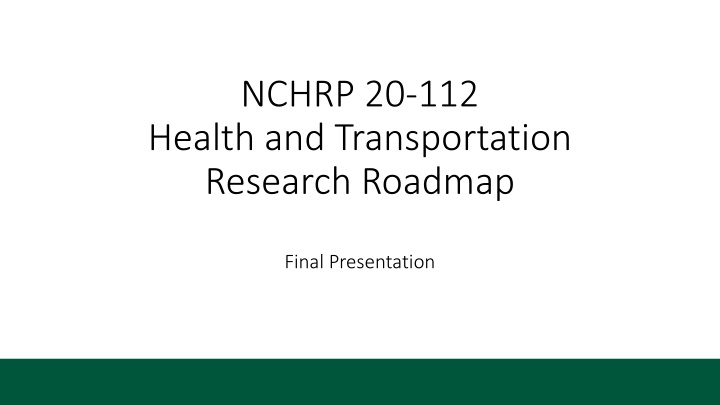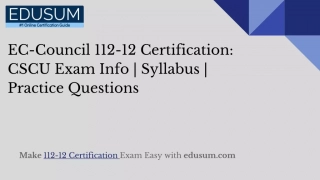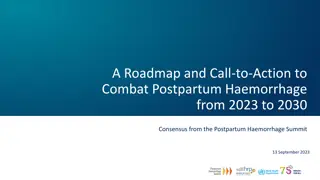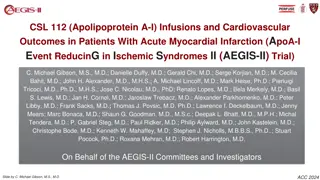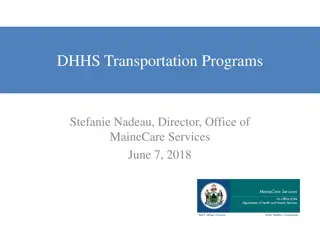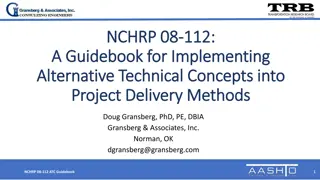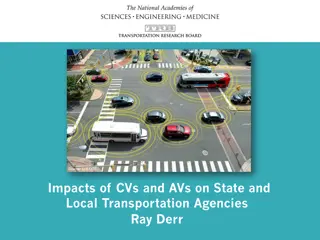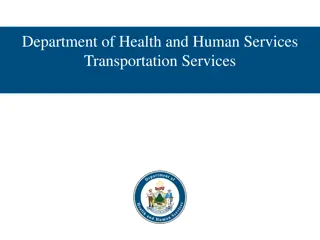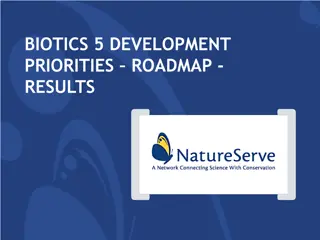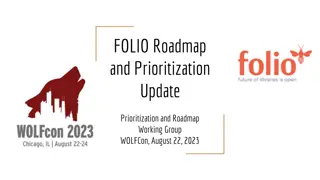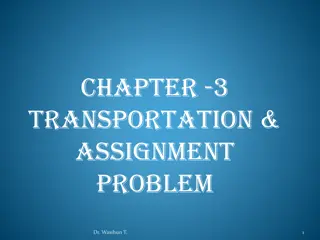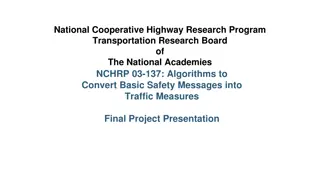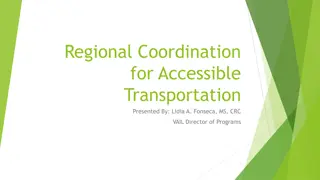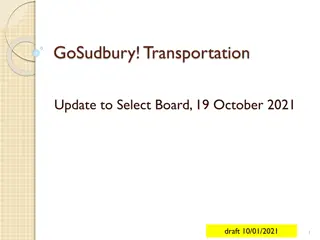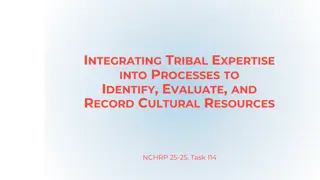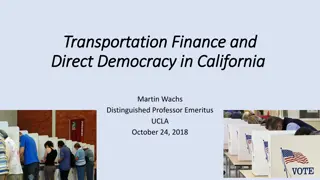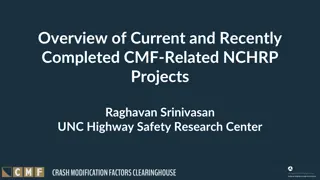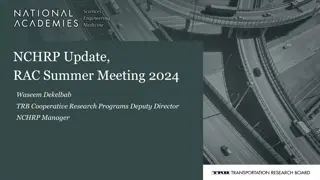NCHRP 20-112: Health and Transportation Research Roadmap
"Explore the intersection of transportation and public health in the United States through a holistic research roadmap, focusing on key factors influencing health status and delivering practical tools and recommendations for state DOTs and partners. The project aims to address state DOT practices and prioritize active travel, community, access, and equity. Key deliverables include a 10-year strategic roadmap and problem statements."
Download Presentation

Please find below an Image/Link to download the presentation.
The content on the website is provided AS IS for your information and personal use only. It may not be sold, licensed, or shared on other websites without obtaining consent from the author.If you encounter any issues during the download, it is possible that the publisher has removed the file from their server.
You are allowed to download the files provided on this website for personal or commercial use, subject to the condition that they are used lawfully. All files are the property of their respective owners.
The content on the website is provided AS IS for your information and personal use only. It may not be sold, licensed, or shared on other websites without obtaining consent from the author.
E N D
Presentation Transcript
NCHRP 20-112 Health and Transportation Research Roadmap Final Presentation
Presentation Overview Background Project Activities Goals, scope, tasks, and deliverables Research Roadmap Conclusions
Background World Health Organization (WHO) offers a basic definition of health: a "state of complete physical, mental and social well-being and not merely the absence of disease or infirmity. Transportation infrastructure and services, and related policies and designs, have been identified as a key factor influencing or determining health status. Background | Project Activities | Key Findings | Research Roadmap | Recommendations
Pathways to Health Safety Resiliency Environment Access Health domains relevant to DOTS Active Travel Community Background | Project Activities | Key Findings | Research Roadmap | Recommendations
Project Goals and Scope Develop a holistic and strategic research roadmap providing a broad overview of highly relevant research needs at the intersection of transportation and public health in the United States. Identify evidence to support practical and useful information, and implementable tools, for state DOTs and partners. Background | Project Activities | Key Findings | Research Roadmap | Recommendations
Project Deliverables 10-year strategic roadmap Six specific Research Problem Statements Communications/implementation plan PowerPoint slides Technical report Database of literature (not required but provided upon request) Background | Project Activities | Key Findings | Research Roadmap | Recommendations
Guiding Principles and Priorities Focus on State DOT practices/interests/needs Also serve: regional/local agencies and health practitioners Priorities of the panel: Emphasize active travel, community, access, and equity Lower priority: traditional DOT areas of work and research (safety and environmental impacts on health) Background | Project Activities | Key Findings | Research Roadmap | Recommendations
Project Activities Literature collection, tagging, review, and synthesis Stakeholder identification and interviews Draft outline of strategic research roadmap (revised with panel input) Panel review/prioritization of needed research problem statements Additional stakeholder input on research problem statements Development of draft and final deliverables Background | Project Activities | Key Findings | Research Roadmap | Recommendations
Literature Review Process 300+ research articles referenced in Final Report 30+ Institutional and agency reports Including committee/task force reports State of practice/case studies and other gray literature 12+ Strategic plans From agencies including USDOT/FHWA, EPA, DHHS, National Institute on Aging, NIH, and Step It Up! The Surgeon General s Call to Action to Promote Walking and Walkable Communities 42+ TRB Research Needs Statements and Research in Progress records Background | Project Activities | Key Findings | Research Roadmap | Recommendations
Stakeholder Engagement Federal, state, and local stakeholders with various geographies/roles: Rural and urban states and cities Planning or analysis, policy, engineering design, program evaluation, etc. Staff in transportation agencies and also some in public health TRB committee members and researchers CDC and USDOT Identified by: Role in prior health and transportation related efforts or research Referrals made by other stakeholders interviewed Pre-interview questionnaire Background | Project Activities | Key Findings | Research Roadmap | Recommendations
Findings: Existing Research Wealth of research showing health impacts of transportation infrastructure and policies Large body of literature on Health Impact Assessments (HIAs) as a tool to consider health impacts in transportation and other projects Many studies to document the development and evaluation of health- related policies, plans and programs: Complete Streets Vision Zero Health in All Policies Safe Routes to School Background | Project Activities | Key Findings | Research Roadmap | Recommendations
Findings: Existing Resources and Guidance Many reports and case studies have shown discrete examples of transportation and health agency collaborations, policies, and practices Background | Project Activities | Key Findings | Research Roadmap | Recommendations
Findings: Existing Tools Table 1 Comparison of Commonly Employed Tools for Assessing the Health Impacts of Transportation Plans Source: National Center for Sustainable Transportation, https://regionalchange.ucdavis.edu/sites/g/files/dgvnsk986/files/inline-files/NCST-TO-033.3-London_ITHIM_Final-Report_OCT-2017.pdf Background | Project Activities | Key Findings | Research Roadmap | Recommendations
Findings: Existing Practices Many innovative approaches to institutionalize health considerations in transportation agency processes and practices: Executive or legislative mandates and policy approaches Intra-department and intra-agency collaboration and staffing agreements Data integration and sharing Applying health decision-making tools in various transportation processes Setting health performance targets and measuring outcomes Pilot-testing new technologies in transit projects Health and physical activity data collection, including ped/bike counts and travel surveys as well as qualitative methods Background | Project Activities | Key Findings | Research Roadmap | Recommendations
Findings: Emerging Issues Less-well documented in the research are issues related to the health impacts and transportation best practices surrounding: Micromobility travel modes (e.g., electric kick/standing scooters) Highly automated vehicles Population-level demographic shifts and related changes in travel behaviors Rising incidence of opioid use/abuse and mental health issues New technology related to transit and shared mobility services Access to healthcare and physical activity opportunities in rural settings Big data access, management, and analytics to support decision-making Background | Project Activities | Key Findings | Research Roadmap | Recommendations
Findings: General Knowledge and Research Gaps Lack of basic resources for transportation and health practitioners to use to build a common understanding of key terminology and respective processes (aka, health in transportation literacy) Lack of data fundamental for research or practice Lack of research to develop models and decision-making tools Lack of practitioner-oriented guidance on implementing research or best practices Or, in some instances, guidance/examples are available but under-utilized Lack of understanding of where approaches are applied and documentation of current and best practices Or, lack of examples from diverse contexts (e.g., rural areas) Background | Project Activities | Key Findings | Research Roadmap | Recommendations
Findings: Topic Specific Research Gaps (Selected) Evaluations of health outcomes related to transportation pricing and policy measures intended to decrease auto-dependency Enhanced data, methods, and metrics for measuring accessibility, community well-being, and equity Data and methods for quantifying health related costs and benefits Research examining the role of transportation projects in relation to housing affordability and health equity Resiliency and recovery practices Background | Project Activities | Key Findings | Research Roadmap | Recommendations
Findings: Topic Specific Research Implementation Gaps (Selected) Lack of best practices, challenges, and lessons in: Collecting and analyzing non-fatal injuries involving active travel modes Institutionalizing practices for collection and integration of active travel data (such as counts, trip-making) Aligning policies and performance measures with health and equity goals Applying tools and checklists to consider health during project scoping and project development Background | Project Activities | Key Findings | Research Roadmap | Recommendations
Research Roadmap Framed around key transportation agency processes and practices Community Engagement / Data Integration Public involvement Coordination with local, regional, and tribal governments Data Collection Performance metrics Policy-making Planning Long-range plans Mode-specific plans Corridor studies Scenario plans Small area plans Capital programs, projects and implementation Project evaluation Project selection Environmental assessment Monitoring and Evaluation Design review and comparison Construction Operation Maintenance Vision and/or Mission Statewide multimodal transportation plan Agency guidance Background | Project Activities | Key Findings | Research Roadmap | Recommendations
Research Problem Statement Topic Identification Panel ranked gaps based on urgency and magnitude of the problem Project team scored specific needs to fill gaps based on: Practicality Innovation Scalability Equity addressed Health outcomes addressed Transportation modes addressed High ranking needs within priority gap areas were selected for development. Background | Project Activities | Key Findings | Research Roadmap | Recommendations
Research Problem Statement Topics Developed 1. Synthesis of Best Practices for Including Health Outcomes in Transportation Project Prioritization Data Sources for Establishing Health Outcome Performance Measures for Transportation Projects Practices and Recommendations in Reporting and Integrating Pedestrian and Bicycle Non-Fatal Injury Data Systems A Guidebook for Considering the Public Health Impacts of Public Transportation Decisions Effect of Demographic Change on Travel Behavior and Health Evaluating and Integrating Emerging Data Sources to Support Transportation and Health Planning and Operations 2. 3. 4. 5. 6. Background | Project Activities | Key Findings | Research Roadmap | Recommendations
Implementation Plan: Call to Action Share project deliverables widely: AASHTO committee mid-year meetings TRB Executive Committee members TRB Health and Transportation Subcommittee Upcoming conferences related to health and transportation Utilize TRB committees (particularly Health and Transportation Subcommittee) to regularly revisit roadmap and advance or update research problem statements Identify state-level champions involved with AASHTO committees Identify NGO, regional/local, and university-based supporters as well Background | Project Activities | Key Findings | Research Roadmap | Recommendations
Potential End Users and Champions AASHTO and TRB: Standing Committee on Environment (SCOE), Standing Committee on Planning (SCOP), subcommittee on performance measurement, and Standing Committee on Highway Traffic Safety (SCHOTS), Active Travel Council, and TRB committees/liaisons State DOT and MPO Research and Data Program Managers Federal agencies: USDOT (FHWA, NHTSA, FTA, OST), CDC, and EPA UTCs: CARTEEH (Tier 1, air quality/environment), Collaborative Sciences Center for Road Safety (National, safety), and National Institute for Transportation and Communities (National, mobility), National Center for Sustainable Transportation (National, environmental preservation) Member organizations: APA, NACCHO, APHA , ITE Health Task Force Foundations and other organizations: Robert Wood Johnson Foundation/Convergence Partnership, Center for Neighborhood Technology, key NGOs, etc. Background | Project Activities | Key Findings | Research Roadmap | Recommendations
Project Team Members Laura Sandt (PI), Alyson West, Kristen Brookshire, Meg Bryson, Sarah Johnson, Kelly Evenson, Jackie MacDonald Gibson Lauren Blackburn, Kara Peach, Margaret Tartala, Curtis Ostrodka Anna Ricklin, Sagar Shah Independent Consultants: Daniel A. Rodriguez, Jason Corburn For more information, please contact Laura Sandt at sandt@hsrc.unc.edu
